

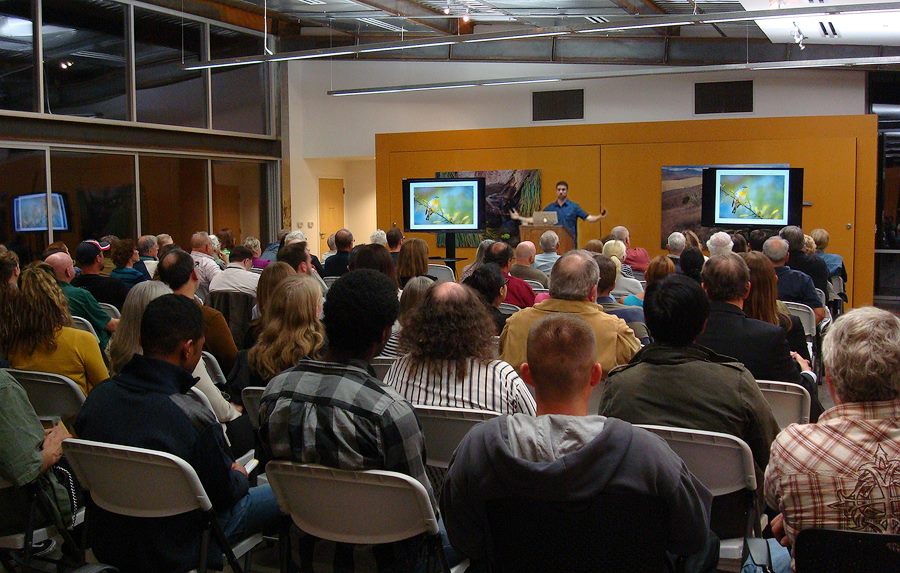
Nathaniel Smalley speaking at the Audubon Arizona Awards Event in Phoenix, AZ.
Recently I was requested as the guest speaker at Audubon Arizona’s showcase event in November, featuring award winning images from the 2015 National Audubon Photography Competition. The event was very well attended and I enjoyed an engaged audience as I discussed the topic of award winning bird photography. Due to the popularity of the topic, I chose to compile some of my notes into a blog post here. Though I haven’t personally invested a lot of time entering my work, I have been asked to be a judge for a number of different nature photography competitions including the distinguished Natures Best Photography – Africa (a division of Nature’s Best Photography), Viewbug.com and others. Birds were my door into photography way back in high school. These days I rarely go anywhere for the sole purpose of watching birds, but that hobby helped shape my career as a professional nature photographer, and as a result birds will always hold a special place in my heart. I now carry a camera in place of my binoculars when out looking for avian subjects. So you might ask, what am I looking for when I photograph birds? Creating successful bird photographs requires one or more different elements in our composition. Obviously there are many that could be listed, but for the sake of simplicity I’ve limited it to 10 elements. In the caption of each photo in this article I have detailed the main elements from this list have been utilized in my photographs. They are as follows:
Action | Behavior | Humor | Personality | Friendship | Light | Perspective | Habitat | Depth of Field | Nostalgia
Despite popular opinion, bird photography isn’t all about having a big lens. While it can certainly help achieve certain images, there are many creative ways to photograph birds that certainly require more effort, but produce great results. This image of a Great Blue Heron in flight was taken with my 70-200mm zoom lens and a teleconverter making it effectively a 400mm lens. Capturing this image came down to being prepared for the bird as it flew in front of me, as opposed to having a piece of high powered glass.
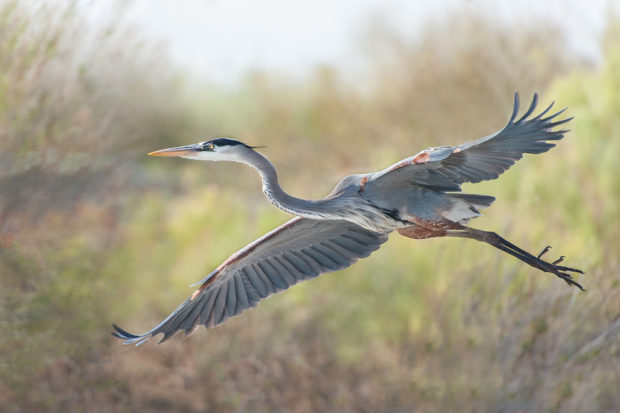
Great Blue Heron – This bird in flight image utilizes action. Camera: Nikon D700 & Nikon 70-200mm Lens w/ 2x Teleconverter – Iso 1,000 | f-5.6 | 1/1600 sec. @ 400mm
To further illustrate my point I want to show you the image below. This is perhaps the most popular photo I’ve ever taken. What camera was it taken with? My Sony Cybershot Point & Shoot, 8 megapixel camera! Sure, it’s not a bird photo, but it proves a point; Creativity and being passionate about your subject trumps expensive equipment every time.
- -This image was licensed by Nikon for a corporate presentation.
- -It has been shared to every corner of the world.
- -Published in international magazines and used in multiple articles.
- -Occupied 1st place on 500px ahead of over-saturated landscapes and photos of half-naked models.


Nathaniel’s infant son Dimitri at one week old – Iso 400 | f-2.8 | 1/25 sec. @ 6mm
So the next logical question then is how does one get close enough to these subjects without spooking them. Birds tend to be very skittish of humans, and for good reason, in fact I’m wary of humans at times myself! When we photograph birds and wildlife we want them to be relaxed and in their natural state. I’m strongly opposed to using bait to lure in wild subjects, but that’s a whole topic in and of itself. (If you would like to read more on the topic of baiting birds and wildlife click on this link). I also refrain from using calls and recordings. As much as possible I want my wild subjects to be acting out their normal behavior patterns as though I was not present. This is when I capture my best images. The longer we sit still and the more we blend into our surroundings the more comfortable birds become with our presence and the closer they will come to us. The clothing colors that we wear can effect how birds react to our presence. Stay away from whites, reds, yellows and other brightly colored clothing, these colors are often associated with danger in the natural world. Instead choose earth tones or even camouflage. Bird blinds are another option allowing us to photograph birds without being detected. Many species are much easier to photograph in the spring when they spend a majority of their time singing, displaying their bright breeding plumage and engaged in territorial disputes. Sometimes a bird will be all but oblivious to human presence during this time of the year as they’re so preoccupied with finding a mate and defending their turf. Below is an American Redstart singing his heart out at Magee Marsh, along the shores of Lake Erie in Ohio. Magee Marsh is a bird photographer’s paradise!
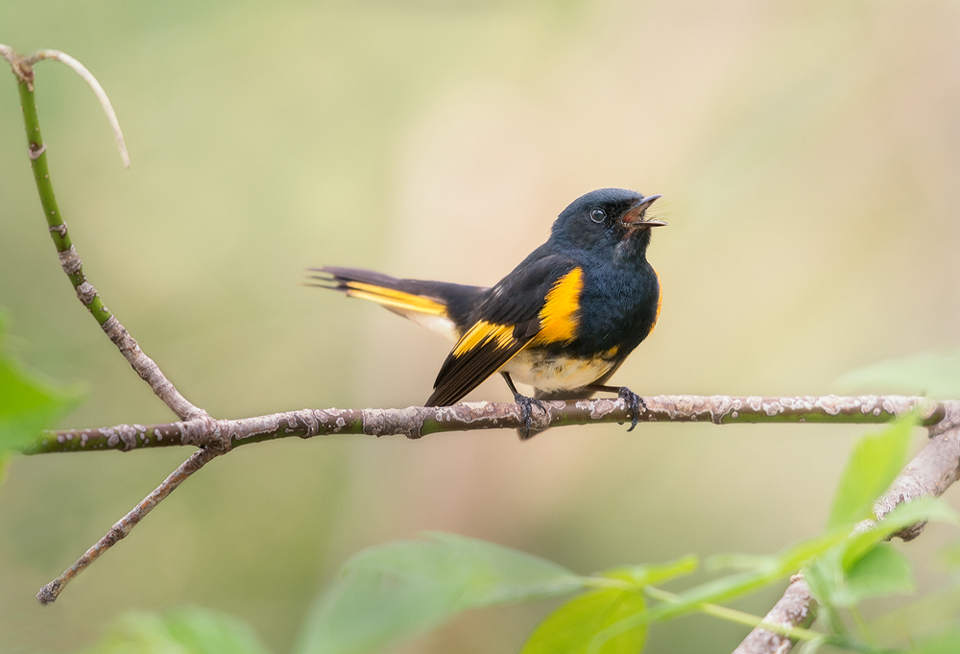
American Redstart – This image illustrates behavior & action. Camera: Nikon D800e & Nikon 600mm Lens w/ 1.4x Teleconverter – Iso 1,250 | f-7.1 | 1/250 sec. @ 850mm
Conversely, nesting season can be one of the most difficult times to photograph birds, as they are trying to be secretive and all their attention is consumed with feeding their young. While nest sites can be intriguing to photograph, one should take extreme caution to do so at a safe distance so as not to stress or make the birds feel threatened. No photograph is worth rising the welfare of the nestlings, regardless of how cute they are.
Even the most common species are popular as babies, like this pair of Herring Gull chicks (above right) navigating through a large patch of ice plant on the California coastline. For this image I climbed on top of a railing along the ocean cliff to get even higher perspective (see below). This allowed me to shoot down on my subjects and isolate them in the frame from one another. If I’d shot them straight on then they would have blended together into a fluffy blob with two heads.

Nathaniel on location at La Jolla Cove in San Diego, California © Laurie Rubin
Capturing fledglings in their natural element in great light can produce some really magical results. Below a baby Canada Goose is struggling to put down a large dandelion blossom. The early morning sun on the dew covered grass creates the perfect shooting conditions for an image like this. I got low to the ground on eye level with my subject to help put the size of the surroundings in perspective. Using a shallow depth of field helps to isolate the gosling from the habitat and draws the viewers attention directly to the subject.
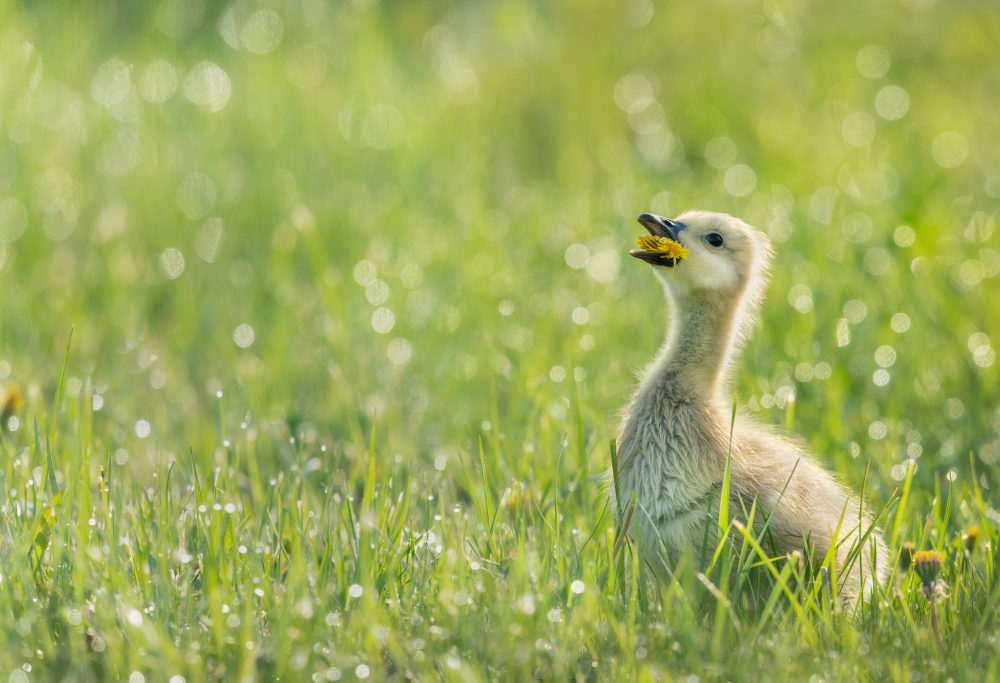
Canada Goose – This image utilizes light (dramatic), perspective & depth of field. Camera: Nikon D800e & Nikon 600mm Lens – Iso 1,000 | f-6.3 | 1/2000 sec. @ 600mm
By getting very low to the ground when shooting this Golden Plover chick, the subject appears much smaller and more vulnerable in the overall scene, which is what I was going for. This impression is enhanced by the fact that I centered the subject and composed the bird low in the frame with lots of negative space above it. This image breaks one of the main rules of composition, known as ‘The Rule of Thirds.’ The rule of thirds states that: ‘An image is most pleasing when its subjects or regions are composed along imaginary lines which divide the image into thirds – both vertically and horizontally ’. This just goes to show that all the ‘rules ‘ of photography are made to be broken.
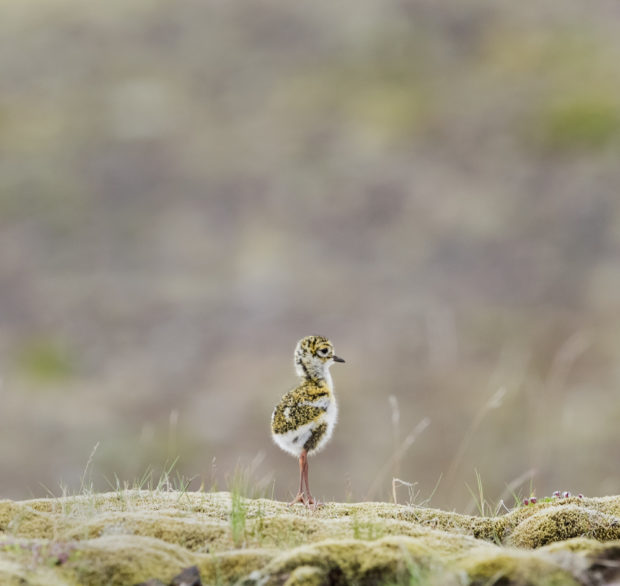
Golden Plover chick – This image utilizes perspective & depth of field. Camera: Nikon D4s & Nikon 600mm Lens – Iso 1,000 | f-6.3 | 1/320 sec. @ 600mm
Unlike the previous example, this image below was composed following ‘The Rule of Thirds’. You can see the owl’s eyes, as the primary point of interest, are located right where the top left intersecting lines meet. This photo has nice balance to it with the double Aspens on the right offsetting the ‘weight ’ of the owl on the left. I’ve used depth of field to manage how much of the surrounding habitat is in focus.

Great Gray Owl – This image utilizes habitat, depth of field & perspective. Camera: Nikon D800e & Nikon 600mm Lens w/ 1.4x Teleconverter – Iso 400 | f-8 | 1/320 sec. @ 850mm
With bird photography almost every image will have more impact if you can get on eye level with your subject. Sometimes photographers don’t put a lot of thought into the angle at which an image is taken, but considering the role it plays in creating a successful image it aught to get far more attention. People are instinctively drawn to an photo taken from an unusual angle. For the image below I had my tripod in the water and was laying down with the upper half of my body stretched out over the edge of the bank to operate the camera and capture this shot. Needless to say that is not a comfortable position to be in, but often capturing the best shot requires a bit of physical discomfort to achieve the desired results.
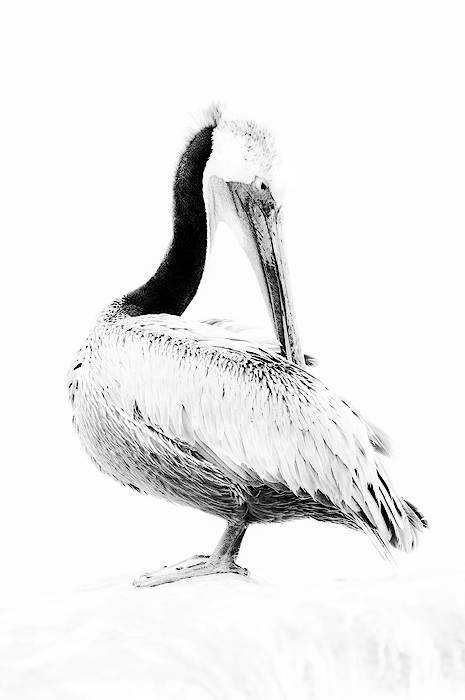
Brown Pelican – This image utilizes fine art & behavior. Camera: Nikon D4s & Nikon 600mm Lens – Iso 1,250 | f-7.1 | 1/100 sec. @ 600mm
A fine art photograph is taken with the goal of creating a work of art. It goes beyond the literal aspect of the scene or the subject photographed and creates an image that shares the photographer’s personal vision, a metaphorical aspect or message. This type of photography is more about making a photograph, not just taking a photograph. Documentation is great for certain types of photography, such as forensics where the purpose is to record the scene in the most literal and factual manner possible, but fine art photography is is about more than just creating a documentary image. While defining exactly what constitutes fine art photography may be impossible, here are a few points to consider in describing it:
- 1). What a fine art photograph illustrates must be different from what is observed when the shot is taken.
- 2). The purpose of a fine art photograph is to share the photographer’s personal vision of the scene or subject.
- 3). When looking at a fine art photograph it’s clear that the photograph was created by an artist and not just by a camera.
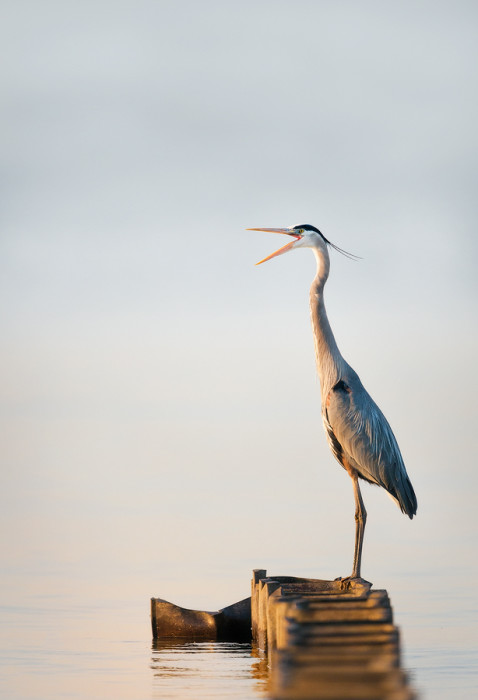
Sunset Salute | Great Blue Heron
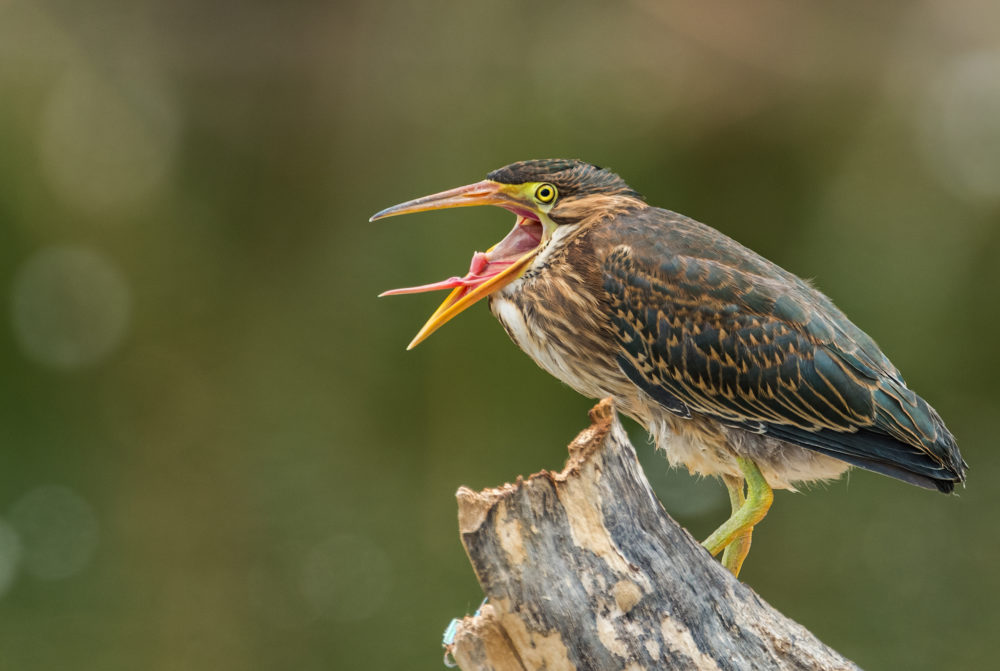
Green Heron – This image utilizes action & behavior. Camera: Nikon D4s & Nikon 600mm Lens w/ 1.4x Teleconverter – Iso 640 | f-7.1 | 1/800 sec. @ 850mm
Often after catching and swallowing a large fish a heron will open and close its beak activating its throat muscles and helping it to fully swallow its meal. Knowing of this behavior and watching for it allows you to capture a shot like this one of the Great Blue Heron on the right and gives the impression of a loud audible call from your subject.
That is exactly what I was going for when I took the image below of this Green Heron. It looks as though the heron is screaming at the top of its lungs, when in reality it was simply trying to work down its morning meal.
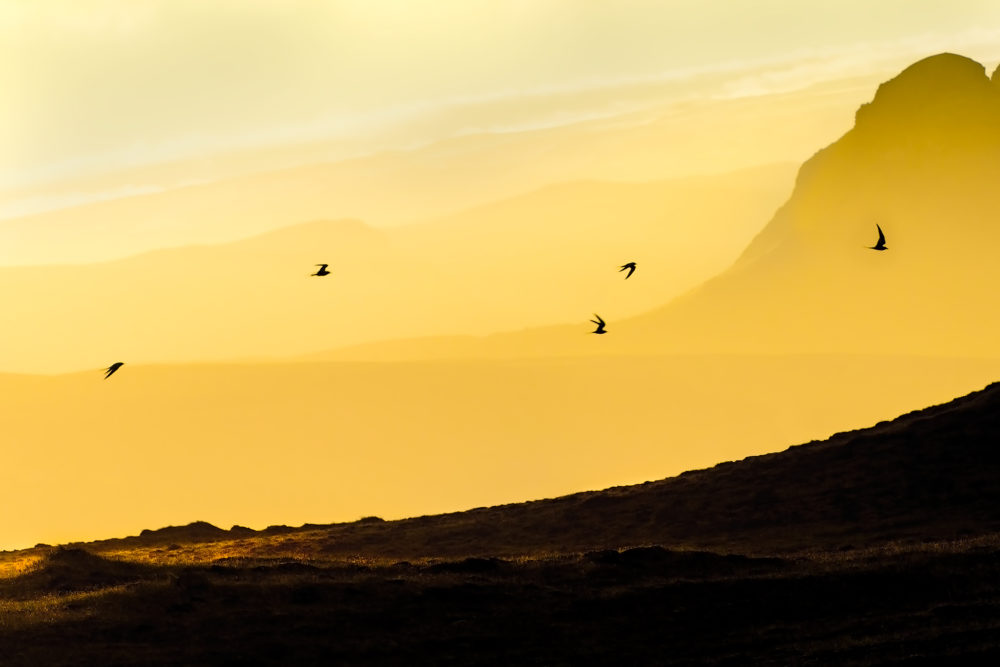
Arctic Terns – This image utilizes action & light (dramatic). Camera: Nikon D700 & Nikon 70-200mm Lens w/ 1.4x Teleconverter – Iso 500 | f-14 | 1/200 sec. @ 220mm
Shooting into a glowing sunset certainly has its challenges as images can easily end up over-exposed. Be sure to take care not to look through the viewfinder when shooting directly towards the sun, use the live view function on your camera if possible. You’ll notice that I’ve composed this image with the sun just to the left of the frame to allow me to shoot while looking through the viewfinder. When the sun is still above the horizon, sunrise and sunset can provide photographers lots of light to work with, and as a result you are able to shoot at faster shutter speeds and freeze motion or smaller apertures for greater depth of field. That is exactly what I’ve done here with this flock of Arctic Terns over the coast of Iceland. In the image below I have taken advantage of the extra light to shoot at f-14 giving me more depth of field in the image and showing more of the layers in the distant hills.
Back light can give an photo a very special effect and enhance shapes and forms. Back lighting works best when the details on the edges are more important than the colors of the subject. Here a Snowy Egret is beautifully illuminated by an early morning beam of light that perfectly highlights a stray feather on its chest. In a shot like this I’m adjusting my camera settings based on the reading from my camera’s light meter is giving me for the brightest parts in the image. By doing this most (if not all) of the distracting back ground elements fall off into the shadows and help to further isolate and emphasize the subject.
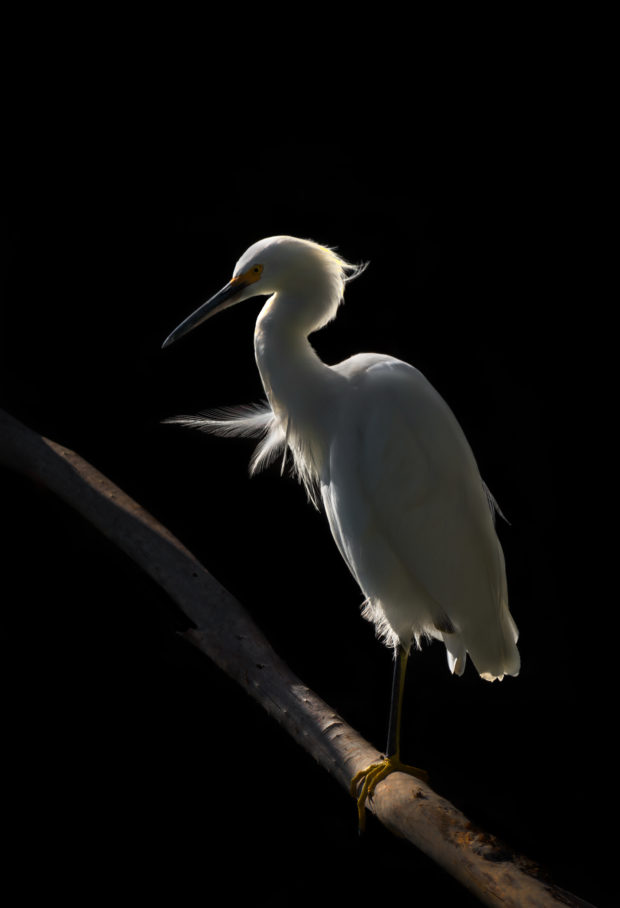
Snowy Egret – This image utilizes light (dramatic). Camera: Nikon D4s & Nikon 600mm Lens – Iso 100 | f-8 | 1/1000 sec. @ 600mm
When seeking bird subjects to photograph there are a few questions we can ask ourselves that will aid us in finding them in the best conditions. What is the dominant habitat for the location you are photographing? Researching the region and knowing the geography will aid you in being better prepared for the type of vegetation and/or terrain you’ll be working in. For most bird species the year is divided into different activities (migration, nesting etc.). Understanding what birds are doing at different times of the year will help you learn when is the best time to photograph them. Where do the birds in your part of the world like to nest and feed? Discovering where their food sources are will lead you to the birds. In the image below a Northern Parula Warbler feeds on small insects inside the seed heads of an Alder Tree, knowing this information makes locating my subject more predictable.

Northern Parula Warbler – This image utilizes habitat & light (soft). Camera: Nikon D800e & Nikon 600mm Lens w/ 1.4x Teleconverter – Iso 800 | f-6.3 | 1/1250 sec. @ 850mm
Depending on what part of the world you grew up in, seeing a Robin in a blooming Crab Apple Tree can be synonymous with spring and feelings of happiness. Having grown up in New England shots like this one of an American Robin bring back great memories for me personally. Capturing a familiar subject in an identifiable scene often takes a bit of planning, but when it is done right you can create a heartwarming photo that has a lot of appeal in front of the right audience. Photos that resonate with a viewer often do so because there is some nostalgic connection that they have with the image. I can’t track how many times I’ve been told by clients purchasing a print that they were ‘buying a hummingbird photo because their mom loved hummingbirds and the photo reminds them of their mother’, or they simply ‘had to have that print of the ocean because they grew up on the coast and the photo reminded them of home’.
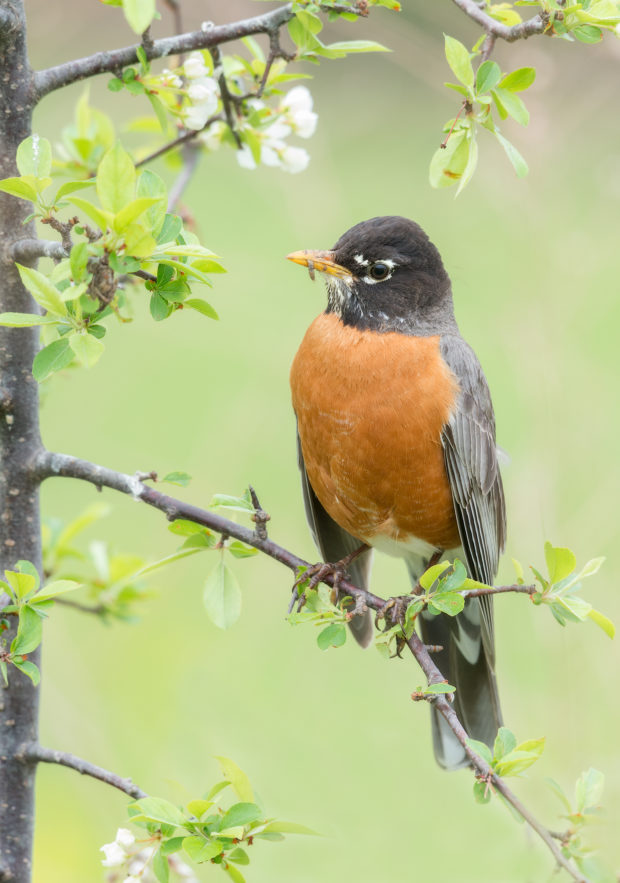
American Robin – This image utilizes nostalgia & habitat. Camera: Nikon D800e & Nikon 600mm Lens – Iso 800 | f-8 | 1/200 sec. @ 600mm
This look of a Burrowing Owl in the image below is achieved by photographing it from just the right angle and produces the look of a stern school master (or perhaps your father when he’s angry at you). Capturing birds from the best angle and at the perfect moment can yield exceptional results that give your subject a personality all its own. Photos of birds and wildlife that show a recognizable personality immediately resonate with the viewer and tend to be very popular.
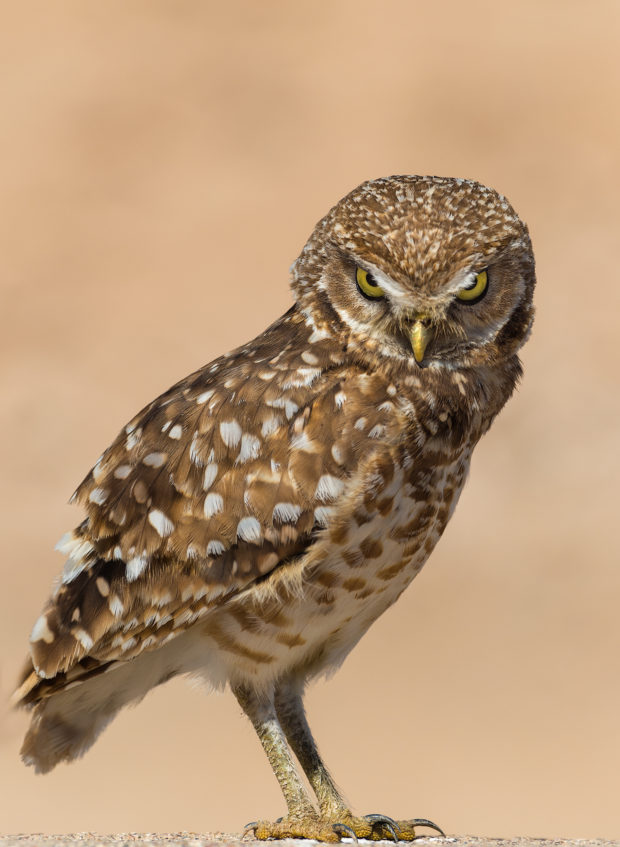
Burrowing Owl – This image utilizes personality & behavior. Camera: Nikon D4s & Nikon 600mm Lens – Iso 200 | f-6.3 | 1/3200 sec. @ 600mm
Images that illustrate friendship between two wild subjects (whether actual or perceived), always evoke positive responses. Places where birds and wildlife both find food sources together are great locations to look for this kind of interaction and capture these types of shots. I found this sea lion and cormorant sunning themselves together on a rock along the coastline of California.
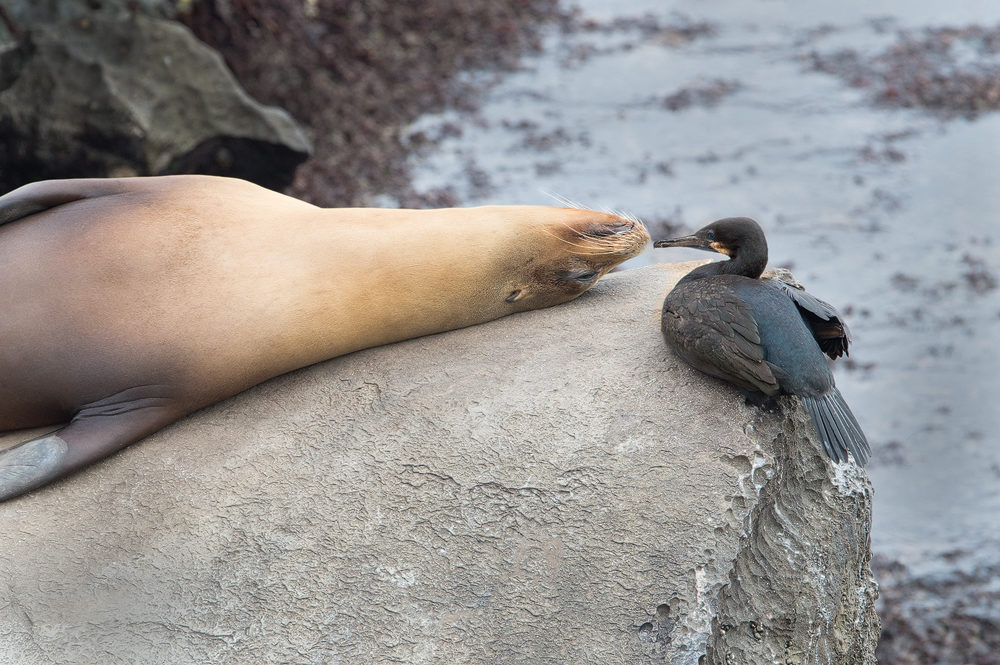
Sea Lion & Cormorant – This image utilizes friendship & habitat. Camera: Nikon D4s & Nikon 600mm Lens – Iso 800 | f-8 | 1/320 sec. @ 600mm
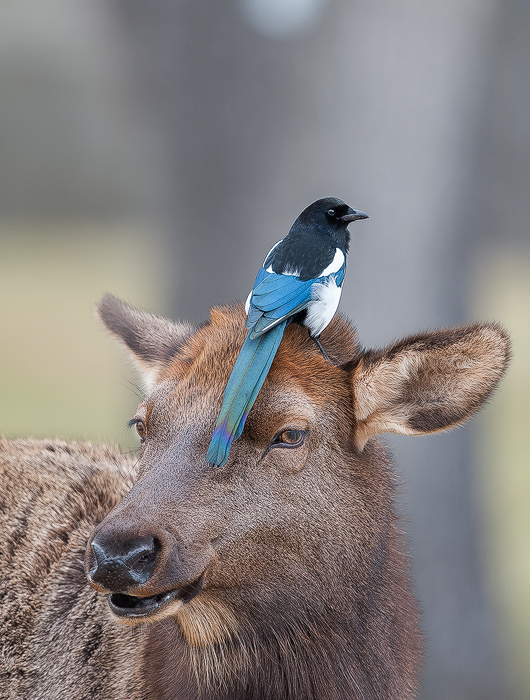
Elk & Magpie – This image utilizes friendship & humor. Camera: Nikon D700 & Nikon 600mm Lens – Iso 400 | f-4| 1/350 sec. @ 600mm
I can’t emphasize enough the importance of studying bird behavior in the field. That’s how I was able to be prepared for a shot like the one to the right of the elk and magpie. I watched this magpie that was hanging out with a herd of Elk, eating parasites out of their fur and foraging underneath their feet. I witnessed it fly up and land on this one elk’s back numerous times before I got the opportunity to capture this shot. Anticipating bird behavior is absolutely essential for capturing winning bird photographs. Also be sure to read up in your bird field guide. There have been numerous birds that seeing them for the first time I immediately knew what they were just from having looked at them in my bird field guides or having read about their behaviors so many times in the past.
The final image I’ll discuss is by far the most comical image I’ve ever captured. This photo below of a Sandhill Crane was taken before I’d really gone full time with my photography, but it is consistently one of my best selling photographs. This image is also one of the few images of mine that I’ve entered into a photography competition. However, when I did in 2012, it took home Honorable Mention from the National Wildlife Federation Nature Photography Competition. People love humorous images of birds and wildlife so I jump at the opportunity to capture a photograph like this. It’s also the only image from my bird portfolio that was taken in captivity. This photo was shot on an a family outing there with my children at the Sandhill Crane exhibit in the Phoenix Zoo. Since beginning to work as a professional photographer I no longer take photographs of captive subjects. All the photos that you’ll see on my website were taken in the wild.
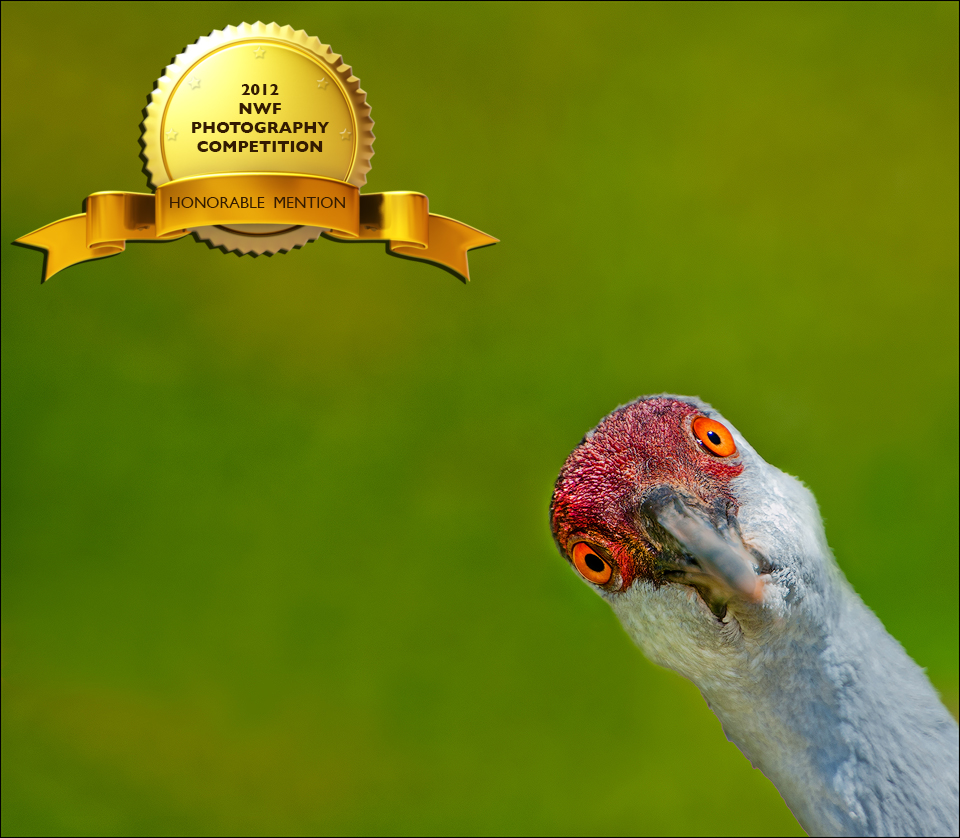
Sandhill Crane – This image utilizes humor & personality. Camera: Nikon D700 & Nikon 70-200mm Lens w/ 2x Teleconverter – Iso 200 | f-5.6 | 1/640 sec. @ 400mm
In conclusion I’ll say that the absolute best way to produce award winning images is to get outdoors with your camera. The more you’re out in the wild looking for avian subjects and watching bird behavior, the greater your odds are of seeing and capturing an exceptional image. After all, even if you don’t get the image you’re chasing after, I can’t think of a better way to spend the day than being outside surrounded by your feathered friends. So boost your award winning potential, and grab your camera… the birds are calling.
Your thoughts and comments are always welcome.
– Nathaniel
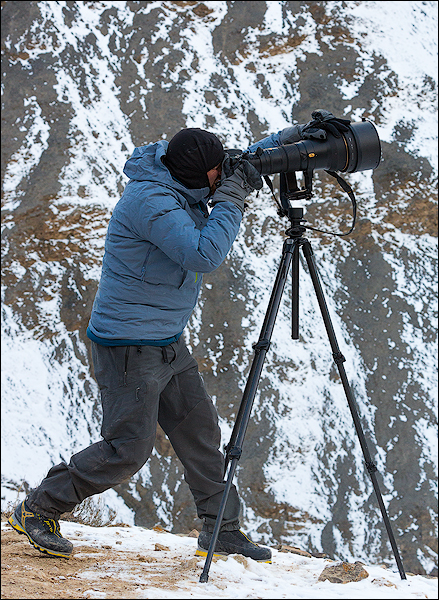
Nathaniel on location in the Himalayas photographing raptors. – India, 2015
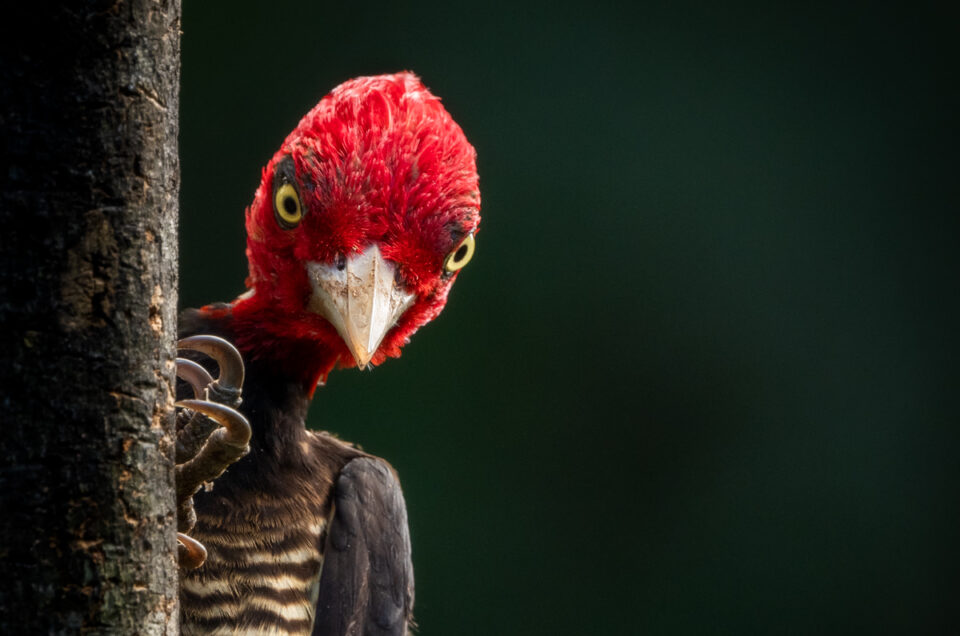

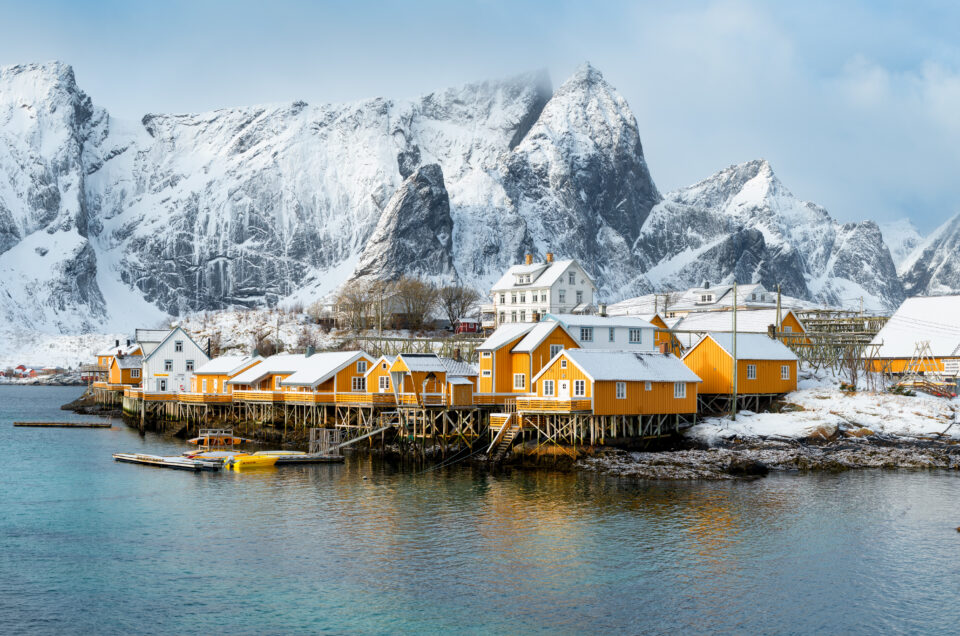
6 Comments
You images have always reached me in a personal way. Your article is very informative; it’s always nice to hear the story’s behind the image. Thank you for sharing!
Thank you so much for the kind words and for following my photography, I appreciate your feedback!
Cheers!
Nathaniel
I love your photography and also use a Nikon 800. Have the 200-400 and am considering a stronger lens of good quality that produces sharp images at both end. Do you have recommendations. Read Sigma reviews of the lens that goes to 600. Sharpness may be a problem.
Thank you for reading my article Maureen and I’m glad you enjoy my work. I have not used Sigma lines in a long time, but I’ve heard that they work well with Nikon camera bodies. Any zoom lens may have sharpness issues at either end of the spectrum, either zoomed out or zoomed all the way in. I’d suggest either visiting a camera store and trying it out on your camera body first or renting it before buying one. I recommend ATS rentals: http://www.ATSrentals.com
Cheers!
Nathaniel
You are capturing nature as some may never get to see. Absolutely a dream come true. I wish more young children, and adolscents, were being taught the same love, that some of us have, and see, for our wildlife.
Yes, it definitely is a dream Luanne and I agree with you completely, kids need more exposure to nature.